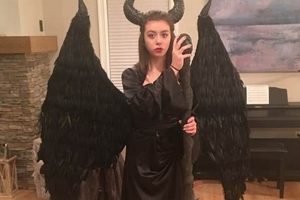The act of creating a homemade rendition of a character known for toxic foliage involves the design and assembly of apparel and accessories. Typically, this undertaking incorporates green fabrics, often adorned with stylized leaf shapes, to emulate the character’s signature botanical appearance. An example would be constructing a dress or bodysuit and then attaching artificial leaves to the garment.
Engaging in such a creative project offers several advantages. It provides a cost-effective alternative to purchasing pre-made outfits, allows for personalized customization to reflect individual style, and fosters artistic expression through the selection of materials and design elements. Historically, creating attire at home has been a means of self-sufficiency and a way to uniquely express oneself at gatherings or events.
The following sections will delve into specific techniques for crafting different elements of this thematic ensemble, exploring material options, construction methods, and potential safety considerations when replicating the iconic look.
Crafting the Botanical Villain
The following provides essential advice for constructing a successful representation of the botanical villain through do-it-yourself methods. Adherence to these guidelines will enhance the quality and authenticity of the final result.
Tip 1: Fabric Selection is Paramount: Prioritize selecting appropriate green fabrics. Consider variations in shade and texture to create visual interest. Stretch velvet, faux leather, or even repurposed materials can contribute to a dynamic and interesting appearance.
Tip 2: Leaf Construction Techniques: Artificial leaves can be purchased or crafted. For homemade leaves, utilize craft foam or felt. Patterns can be traced and cut to ensure uniformity, and veins can be added with fabric markers or paint for enhanced realism.
Tip 3: Secure Leaf Attachment: Utilize strong adhesives, such as fabric glue or hot glue, to firmly attach the leaves to the chosen garment. Test the adhesive on a small, inconspicuous area of the fabric first to ensure compatibility and prevent damage.
Tip 4: Consider the Silhouette: Design the outfit to accentuate the desired shape. Corsets, strategic draping, and padding can be employed to achieve the iconic hourglass figure often associated with the character.
Tip 5: Embellishments Enhance Realism: Incorporate subtle details such as vines made from twisted wire covered in green ribbon or strategically placed berry accents to further enhance the botanical aesthetic. Ensure embellishments are securely attached and do not pose a snagging hazard.
Tip 6: Makeup and Hair Considerations: Complement the apparel with appropriate makeup. Green eyeshadow, dramatic eyeliner, and red lipstick are common choices. Style hair in voluminous waves or curls to complete the transformation.
Tip 7: Prioritize Comfort and Mobility: While aesthetics are important, ensure the finished garment allows for comfortable movement and wearability. Consider the duration of wear and any activities planned while wearing the outfit.
The careful execution of these recommendations will contribute to a visually striking and authentic representation. Attention to detail and quality materials are crucial for achieving the desired impact.
The subsequent section will explore the specific accessories that can further enhance the outfit and solidify the thematic presentation.
1. Leaf Texture
The selection of leaf texture plays a critical role in the overall effectiveness of a homemade botanical villain representation. The texture directly influences the perceived realism and aesthetic appeal of the outfit. Smooth, glossy textures, such as those achieved with satin or vinyl, create a sleek, almost artificial appearance, potentially lending a more modern or stylized interpretation. Conversely, rougher textures, like those found in felt or crushed velvet, evoke a more natural and organic aesthetic. An ill-considered texture can detract from the illusion and diminish the impact of the ensemble. For example, using overly stiff or plastic-looking leaves may result in a less convincing or even cartoonish outcome.
The interplay between leaf texture and garment construction further amplifies this effect. A flowing dress made from lightweight chiffon adorned with delicate, veined leaves creates a markedly different impression from a form-fitting bodysuit covered in rigid, glossy foliage. Furthermore, lighting conditions significantly impact how textures are perceived. Under bright illumination, subtle variations in texture become more pronounced, while in dimmer settings, the overall color and shape take precedence. Therefore, material choices must be carefully considered within the context of the anticipated environment where the representation will be displayed.
In summary, leaf texture is a foundational element in crafting a successful and convincing homemade version. The choice of texture has a demonstrable cause-and-effect relationship with the outfit’s perceived quality and overall aesthetic. Understanding this connection enables creators to make informed decisions that elevate their designs and realize a more compelling final presentation. A challenge remains in balancing realistic textures with wearability and comfort, but mindful material selection is a vital first step.
2. Garment Construction
Garment construction is central to the successful execution of a homemade botanical villain representation. The techniques employed directly influence the final aesthetic, fit, and durability of the costume. Effective garment construction ensures the design translates from concept to wearable art, maintaining its visual impact throughout its intended use.
- Pattern Selection and Adaptation
The choice of pattern significantly impacts the base structure of the ensemble. Pre-existing patterns for dresses, bodysuits, or corsets can be adapted to suit the desired silhouette. Modifications may include altering necklines, adding sleeves, or adjusting the overall fit. Accurate pattern adaptation is critical; improperly fitted garments compromise the visual impact and impede movement.
- Seam Integrity and Reinforcement
Strong and well-executed seams are essential for a durable and long-lasting costume. Overlocking or serging raw edges prevents fraying and reinforces stress points. Proper seam placement contributes to the garment’s shape and overall aesthetic. Weak seams can result in rips or tears, especially under the weight of attached leaves or embellishments, diminishing the costume’s appearance and potentially causing wardrobe malfunctions.
- Closure Methods and Functionality
The selection of appropriate closures, such as zippers, buttons, or lacing, influences both the aesthetic and funct
ionality of the outfit. Zippers offer a streamlined appearance but require precise installation. Lacing allows for adjustable fit but may require assistance to fasten. Secure and concealed closures maintain the illusion of a seamless design. Functional closures allow for easy dressing and undressing, promoting both comfort and convenience. - Understructure and Support
The understructure of the garment provides shape and support, ensuring the costume maintains its intended form. Corsets, boning, and padding can be incorporated to achieve a desired silhouette. A well-constructed understructure enhances the wearer’s figure and provides a stable base for attaching embellishments. Poorly designed or absent understructure can result in a shapeless or unflattering appearance.
In conclusion, garment construction is a fundamental determinant of a homemade costume’s success. Proper pattern adaptation, seam integrity, closure functionality, and supportive understructure are all crucial elements. Attention to these construction details ensures not only a visually compelling aesthetic but also a comfortable and durable wearable representation.
3. Color Palette
The selection and application of a color palette is paramount in crafting a recognizable and impactful botanical villain ensemble. The chosen colors dictate the mood, realism, and overall visual impression, directly influencing the audience’s perception and recognition of the character representation.
- Dominant Green Shades
Green is the foundational color for any botanical villain representation, necessitating careful consideration of hue and saturation. Variations ranging from deep forest green to vibrant emerald can evoke different aspects of the character. Darker shades suggest danger and toxicity, while brighter shades imply allure and vitality. The interplay of multiple green tones adds depth and realism, mimicking the natural variation found in foliage. Monochromatic palettes can create a sophisticated look, whereas contrasting shades provide visual interest and highlight specific features.
- Accent Colors: Red and Purple Tones
Accent colors, particularly red and purple, introduce visual tension and reinforce the character’s duality. Red often symbolizes danger, poison, and seduction, effectively conveying the character’s lethal nature. Purple adds an element of mystique and royalty, elevating the design beyond mere mimicry. The strategic placement of these accent colors, such as on lips, fingertips, or as vein detailing on leaves, emphasizes key focal points and reinforces thematic elements. Careful calibration prevents overpowering the dominant green shades, preserving the essential botanical aesthetic.
- Metallic Accents: Gold and Bronze
Metallic accents, such as gold or bronze, can enhance the costume’s perceived value and sophistication. These tones, subtly applied to leaves, vines, or accessories, create a sense of opulence and power, reflecting the character’s inherent control over nature. Metallic highlights also capture light, adding dimension and visual interest. Overuse, however, can diminish the natural aesthetic and detract from the overall design. Judicious application ensures metallic accents complement rather than overshadow the primary color palette.
- Skin Tone Integration
The chosen color palette must harmonize with the wearer’s skin tone to create a cohesive and visually appealing result. Cooler green shades complement fair complexions, while warmer greens enhance darker skin tones. Makeup choices, particularly eyeshadow and lipstick, should align with the overall color scheme to create a unified aesthetic. Consideration of the wearer’s natural coloring ensures the costume enhances, rather than clashes with, their appearance.
The color palette serves as a powerful tool in translating the essence of the botanical villain into a tangible form. The strategic use of green shades, accent colors, metallic highlights, and skin tone integration collectively contribute to a visually striking and characteristically accurate homemade representation. Balancing these elements is crucial to achieving a compelling and memorable visual interpretation.
4. Accessory Detailing
Accessory detailing is integral to elevating a homemade botanical villain representation beyond mere clothing, imbuing it with character, depth, and recognizable iconography. Meticulously chosen and crafted accessories transform a basic garment into a cohesive and compelling embodiment of the source material.
- Vines and Tendrils
Artificial vines and tendrils serve as a fundamental accessory, emulating the character’s connection to plant life. These can be constructed from wire, rope, or fabric, and strategically draped across the costume to suggest organic growth. The material and placement of vines significantly influence the costume’s overall aesthetic, ranging from a controlled, elegant look to a wild, untamed appearance. For example, delicate wire vines with small leaves create a subtle effect, while thick, rope-like vines convey a more imposing presence.
- Leaf-Adorned Gloves or Gauntlets
Gloves or gauntlets covered in artificial leaves extend the botanical theme to the extremities, enhancing the overall visual impact. These accessories not only contribute to the aesthetic but also offer opportunities to incorporate texture and color variations. For example, velvet gloves adorned with glossy leaves provide a luxurious touch, while leather gauntlets with rough-edged leaves suggest a more rugged persona. The type and arrangement of leaves on the gloves should complement the overall design, avoiding a cluttered or unbalanced appearance.
- Poisonous Berry Accents
Artificial berries, particularly those of poisonous varieties, serve as a subtle yet effective accessory, reinforcing the character’s inherent danger. These can be attached to the costume or incorporated into accessories such as necklaces or bracelets. The color and size of the berries should be carefully considered to maintain realism and avoid overwhelming the overall design. For instance, small, dark berries subtly hint at toxicity, while large, bright berries create a more dramatic effect. Ensuring the berries appear convincingly artificial, rather than cheap or childish, is crucial for maintaining the costume’s sophisticated aesthetic.
- Statement Jewelry: Leaf or Vine Motifs
Statement jewelry featuring leaf or vine motifs can add an element of elegance and sophistication. Necklaces, earrings, or bracelets crafted from metal or other materials, and designed to resemble plant life, serve as eye-catching focal points. The style of jewelry should align with the overall aesthetic of the costume, ranging from delicate and intricate designs to bold and sculptural pieces. For example, a delicate silver necklace with small leaf pendants complements a flowing dress, while a large bronze bracelet shaped like a vine makes a statement against a simpler garment. The jewelry should enhance, not detract from, the costume’s core botanical theme.
The strategic integration of these accessory details contributes significantly to a successful homemade botanical villain representation. Each accessory should be carefully chosen and crafted to comple
ment the overall design, reinforcing the character’s connection to nature and her inherent danger. A well-executed array of accessories elevates the costume from a simple garment to a compelling and recognizable embodiment of the character.
5. Makeup Design
Makeup design serves as a crucial component in realizing a complete and convincing botanical villain representation. The artistry applied to the face transforms the wearer, enhancing the connection between the character’s essence and its visual manifestation. The following explores key facets of makeup design integral to achieving an effective result.
- Green Skin Tones and Foundation
The application of green-tinted foundation or specialized makeup to alter skin tone forms a cornerstone of the transformation. This effect directly alludes to the character’s connection to plant life and inherent toxicity. Experimentation with varying shades of green allows for nuance; for example, olive tones create a naturalistic effect, while brighter greens convey heightened artificiality. The selection of a suitable base influences subsequent color applications and overall aesthetic consistency.
- Eye Enhancement: Green and Earth-Toned Shadows
Eye makeup significantly contributes to portraying the character’s persona. The strategic blending of green and earth-toned eyeshadows creates depth, dimension, and allure. Techniques such as smoky eyes or winged eyeliner can enhance the dramatic effect. Embellishments like glitter or strategically placed artificial leaves further connect the character to botanical elements. This component shapes the gaze, projecting an aura of both seduction and danger.
- Lip Artistry: Defining the Mouth
The lips serve as a focal point for conveying both sensuality and menace. Bold red lipstick is a common choice, symbolizing poison and allure. Darker shades, such as burgundy or black, introduce an element of danger and mystery. Precise application and shaping emphasize the desired expression. Experimentation with lip gloss or metallic finishes adds visual complexity, while careful lining contributes to a defined and impactful shape.
- Contouring and Highlighting: Sculpting the Face
Strategic contouring and highlighting sculpt the face, accentuating key features and creating a more dramatic appearance. Darker shades define cheekbones and jawlines, while lighter shades highlight the brow bone and bridge of the nose. These techniques enhance the bone structure, creating a more striking and memorable appearance. Skillful application ensures a seamless and natural-looking effect, avoiding harsh lines or an overly artificial aesthetic.
Collectively, these makeup design facets contribute to a transformative process, turning the wearer into a recognizable embodiment. Each component complements the costume, enhancing the connection between the character and botanical themes. The result is a visually compelling and impactful representation, showcasing both the artistry of makeup and the essence of the character.
6. Wearability/Comfort
The correlation between wearability and comfort and the successful execution of a homemade botanical villain costume is significant. The absence of comfortable design and construction can directly detract from the wearer’s experience, diminishing both the aesthetic impact and intended portrayal of the character. Costume design prioritizing aesthetics over wearability can lead to restricted movement, skin irritation, overheating, and ultimately, wearer dissatisfaction. For example, a tightly fitted bodice, while visually accurate, can impede breathing and limit mobility, preventing the wearer from fully engaging in character portrayal or social interaction at an event. Similarly, improperly attached leaves can chafe the skin, causing discomfort and distraction. Consequently, prioritizing wearability and comfort is not merely a matter of convenience but a critical aspect of achieving a truly successful and immersive representation.
Practical application of wearability principles involves several key considerations. Fabric selection plays a pivotal role, with breathable, lightweight materials often proving superior to heavier, less yielding options. Seam placement should minimize friction against the skin, and undergarments may require strategic selection to prevent chafing or irritation. Furthermore, attachment methods for leaves and other embellishments demand careful consideration. Securing elements with flexible adhesives or designing attachment points that distribute weight evenly mitigates discomfort. The design should also account for climate conditions, permitting adequate ventilation to prevent overheating in warmer environments. The iterative process of construction should include test fittings to identify and rectify potential sources of discomfort proactively.
In summary, the integration of wearability and comfort into a self-made botanical villain costume directly influences its overall success. Overlooking these factors can compromise the wearer’s experience, detracting from the intended aesthetic impact and character representation. By prioritizing breathable materials, strategic construction techniques, and thoughtful embellishment attachment, creators can ensure a comfortable and immersive portrayal. While achieving visual accuracy remains a paramount concern, the practical necessity of wearability should not be underestimated, serving as a key determinant in the costume’s long-term effectiveness and enjoyment.
Frequently Asked Questions
This section addresses common inquiries regarding the construction and execution of a homemade botanical villain representation, providing clarity on potential challenges and best practices.
Question 1: What are the most durable materials for constructing the leaf elements of the costume?
Durable leaf construction relies on materials such as craft foam, felt, or faux leather. These options withstand wear and tear better than fabrics like paper or thin cotton. Reinforcing edges with sealant or stitching further enhances longevity.
Question 2: How can the wearer avoid allergic reactions to costume components?
Selecting hypoallergenic fabrics and adhesives minimizes the risk of allergic reactions. Thoroughly washing all fabrics before use and conducting a patch test on a small area of skin with adhesives ensures compatibility. Avoiding direct skin contact with potentially irritating materials is paramount.
Question 3: What methods exist for securing vines and leaves to the garment without damaging the fabric?
Secure vine and leaf attachment can be achieved using fabric glue, fusible interfacing, or strategically placed stitching. Avoiding excessive glue application prevents stiffness and fabric damage. Fusible interfacing offers a temporary bond, while stitching provides a more permanent solution.
Question 4: How can the wearer ensure freedom of movement while wearing a form-fitting botanical villain costume?
Freedom of movement can be maintained by incorporating stretch fabrics, such as spandex or knit blends, into the garment’s construction. Gussets in areas of high stress, such as the underarms and crotch, allow for increased range of motion. Avoiding overly tight construction is essent
ial.
Question 5: What are the optimal makeup techniques for achieving a convincing green skin tone?
Achieving a convincing green skin tone requires a high-quality, professional-grade makeup foundation specifically formulated for theatrical use. Layering techniques and setting powders prevent streaking and ensure long-lasting coverage. Proper color correction can neutralize undertones and enhance the green hue.
Question 6: How should the costume be cleaned and stored to prolong its lifespan?
Cleaning and storage protocols depend on the materials used. Hand-washing with mild detergent is preferable to machine washing for delicate fabrics and embellishments. Storing the costume in a garment bag away from direct sunlight and moisture prevents fading and damage.
Understanding these considerations will contribute to a more successful and enjoyable costume creation and wearing experience. Proper material selection, construction techniques, and maintenance practices are key to a lasting representation.
The subsequent section will address related themes, exploring the cultural impact of botanical villain characters and their ongoing influence on design and fashion.
Conclusion
The preceding exploration of the “poison ivy diy costume” has detailed various aspects of its creation, encompassing material selection, construction techniques, color palette considerations, accessory detailing, makeup artistry, and wearability factors. A comprehensive understanding of these elements facilitates the development of a visually compelling and enduring representation.
Ultimately, the endeavor to craft a homemade botanical villain ensemble necessitates a balance of creativity, technical skill, and attention to detail. Successful execution not only yields a striking costume but also serves as an avenue for artistic expression and an appreciation for the character’s enduring cultural impact. Further exploration and refinement of these techniques will continue to enhance the quality and authenticity of future recreations.







